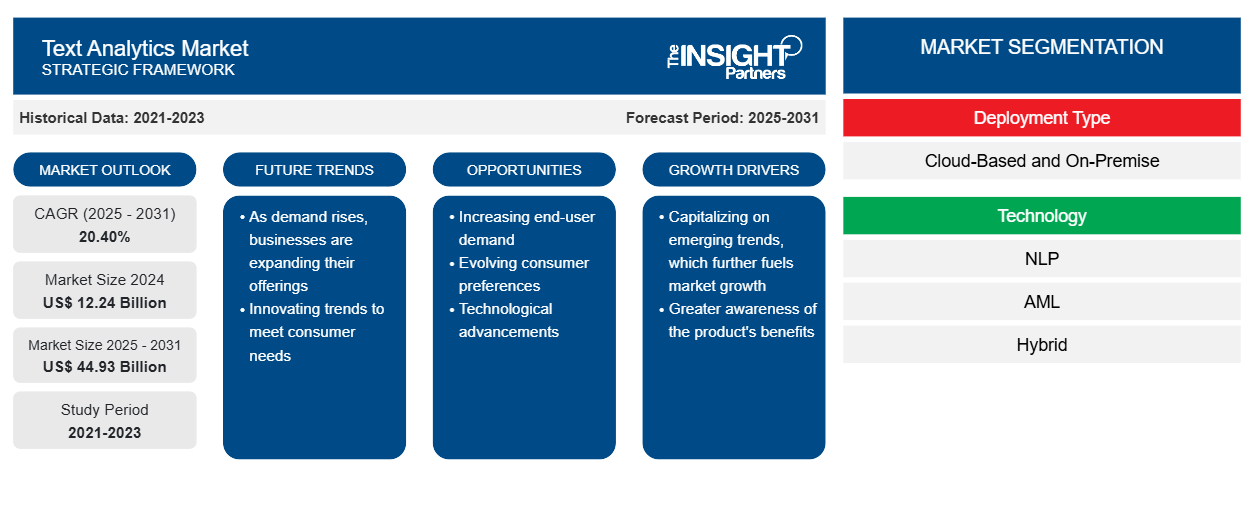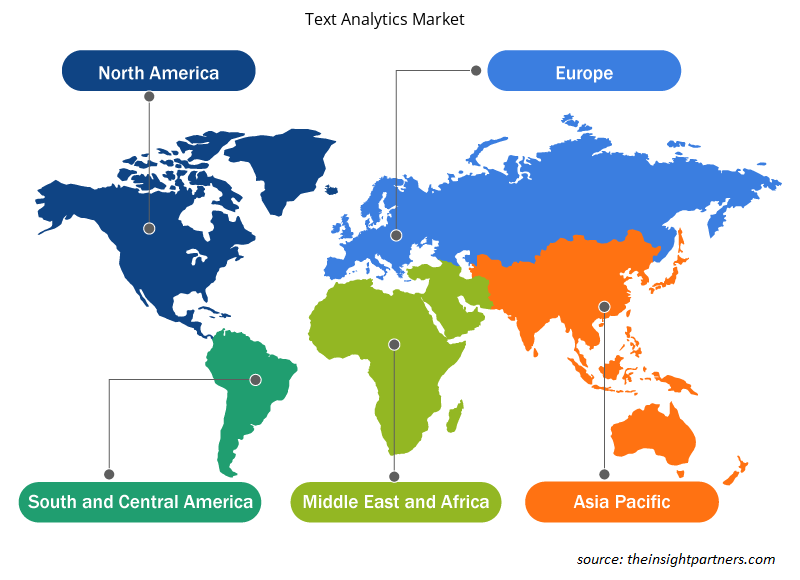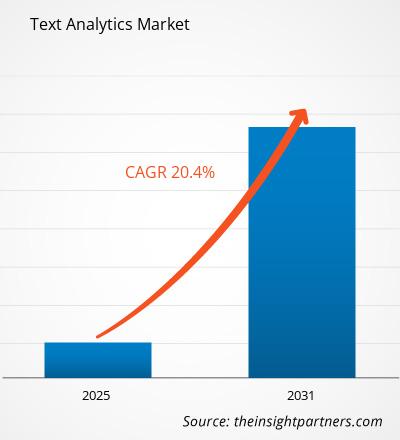The text analytics market is expected to grow from US$ 8.45 billion in 2022 to US$ 27.63 billion by 2031; it is estimated to record a CAGR of 20.4% from 2022 to 2031.
Text analytics plays an increasingly important role in several use cases across different industry verticals. For example, the insurance industry has different and distinct use cases such as claims automation, policy review, and risk engineering that require text analysis. Text analytics allows insurance companies to locate specific information within minimal time. Digital advertising is another end use of text analytics. Unlike a cookie-based approach, contextual advertising analyzes text on a webpage to understand content in an in-depth manner. Widening number of industries using text analytics would drive the overall text analytics market growth.
Owing to increasing competitiveness, companies are seeking advanced analytical solutions capable of utilizing large volumes of data, thereby aiding in better and faster decision-making. With the use of sentiment analysis and voice-of-customer (VoC) solutions, companies can improve customer intimacy and service quality, which enables them to drive customer satisfaction, loyalty, and revenue. The use of text analytics solutions in risk management and fraud detection application in the banking and financial sector helps save millions of dollars over a deal. This will further contribute towards the growth of text analytics market.
Text categorization is one of the prominent use cases of text analytics. The process is based on machine learning and models taken from current datasets, further matching the model data sets with new datasets for making predictions. In text categorization, the end user’s system is fed with a pre-built set of text examples and their relevant categories. A machine learning algorithm learns how each text is categorized and creates rules for itself. When new text is presented, it applies these rules to categorize it. This supervised learning-based approach to text categorization saves the time and effort required to set and implement new rules. Growing demand for text categorization will help in fueling the text analytics market growth.
Customize This Report To Suit Your Requirement
You will get customization on any report - free of charge - including parts of this report, or country-level analysis, Excel Data pack, as well as avail great offers and discounts for start-ups & universities
Text Analytics Market: Strategic Insights

- Get Top Key Market Trends of this report.This FREE sample will include data analysis, ranging from market trends to estimates and forecasts.
You will get customization on any report - free of charge - including parts of this report, or country-level analysis, Excel Data pack, as well as avail great offers and discounts for start-ups & universities
Text Analytics Market: Strategic Insights

- Get Top Key Market Trends of this report.This FREE sample will include data analysis, ranging from market trends to estimates and forecasts.
Regional Analysis of Text Analytics Market
APAC ranked third in terms of text analytics market share in 2022. Continuous growth in the retail, banking, fast-moving consumer goods (FMCG), and healthcare sectors in emerging markets of the Philippines, China, India, and Australia have attracted several international enterprises targeting these economies for the expansion of their business. With the expansion of business into the mentioned countries, their day-to-day functions would create enormous amounts of unstructured text through. This factor is projected to develop growth opportunities for vendors operating in APAC and thus impacting text analytics market. Also, the proliferation of the healthcare sector in Australia, Japan, Taiwan, South Korea, China, Singapore, etc., is anticipated to generate significant demand for text analytics platforms owing to the generation of huge amount of unstructured textual data. ~80% of biomedical data created is unstructured text, which requires text analytics solutions to unlock insights with the use of natural language processing-based solutions.
Owing to continuous technological advancements, it is projected that the advent of different AI regulations in the US, Europe, and Asia will promote the adoption of AI solutions in Asia Pacific by 2031. This adoption will further triggering the machine learning and automated machine learning platform penetration. The use of machine learning platforms would lead to new data categories, thereby expanding the scope of text categorization.
During the COVID-19 pandemic, people’s participation on Twitter, Facebook, and other popular social media platform was tremendous. Twitter was s preferred platform to gather public opinions in the form of comments, reviews, and posts related to COVID-19. Later, different models, tools, and matrices, as well as sentimental analysis, were utilized for classifying public opinions on COVID-19, and also to know situation across the world. The pandemic has positively fueled the text analytics market.
Market Insights – Text Analytics Market
Industry Vertical-Based Insights
Based on industry vertical, the text analytics market size is segmented into BFSI, IT & telecom, healthcare, government & defense, education, retail, manufacturing, and others. In 2022, the BFSI segment accounted for the largest text analytics market share. It includes insurance agencies, commercial banks, mutual funds, non-banking financial companies, cooperatives, banks, and broking firms. Text analytics in the BFSI sector provides a new opportunity for fraud detection. Fraud detection in this sector is achieved through social network analysis or predictive analysis, among other methods. Using text analytics as a method for fraud detection has increased the identification of frauds by more than 50%, as these types of analysis have an accuracy of almost 90%.
The aforesaid stakeholders in the BFSI sector end up into generating and consuming massive amount of unstructured text data from various sources. Thu, the use of advanced text analytics solutions helps the BFSI sector in making data-driven decisions. Topic labeling, intent detection gender detection, semantic similarities keyword extraction, and entity extraction are few text analytics solutions used by financial service providers.
Text Analytics Market Regional Insights
The regional trends and factors influencing the Text Analytics Market throughout the forecast period have been thoroughly explained by the analysts at Insight Partners. This section also discusses Text Analytics Market segments and geography across North America, Europe, Asia Pacific, Middle East and Africa, and South and Central America.

- Get the Regional Specific Data for Text Analytics Market
Text Analytics Market Report Scope
| Report Attribute | Details |
|---|---|
| Market size in 2024 | US$ 12.24 Billion |
| Market Size by 2031 | US$ 44.93 Billion |
| Global CAGR (2025 - 2031) | 20.40% |
| Historical Data | 2021-2023 |
| Forecast period | 2025-2031 |
| Segments Covered |
By Deployment Type
|
| Regions and Countries Covered | North America
|
| Market leaders and key company profiles |
Text Analytics Market Players Density: Understanding Its Impact on Business Dynamics
The Text Analytics Market is growing rapidly, driven by increasing end-user demand due to factors such as evolving consumer preferences, technological advancements, and greater awareness of the product's benefits. As demand rises, businesses are expanding their offerings, innovating to meet consumer needs, and capitalizing on emerging trends, which further fuels market growth.
Market players density refers to the distribution of firms or companies operating within a particular market or industry. It indicates how many competitors (market players) are present in a given market space relative to its size or total market value.
Major Companies operating in the Text Analytics Market are:
- IBM Corporation
- SAP SE
- SAS Institute Inc.
- Clarabridge
- Expert Systems
Disclaimer: The companies listed above are not ranked in any particular order.

- Get the Text Analytics Market top key players overview
The text analytics market players are mainly focused on developing advanced and efficient products.
- In December 2022, Canvs AI unveiled translation for Canvs MRX. This will allow customers to directly analyze open-ended text available in various languages on the Canvs platform. Based on Google Cloud Translation, the translation for Canvs MRX automatically identifies language of an open-ended text on import and translates it to English for processing on Canvs platform.
- In September 2022, expert.ai and AppTek signed a strategic partnership to introduce their AI-based text analytics solution for dynamic audio content in multiple languages. Through this partnership, Automatic Speech Recognition and Neural Machine Translation technologies of AppTek, in combination with natural language understanding capabilities of expert.ai, will allow organizations to take advantages of audio content in an unstructured data set.
The text analytics market size is segmented into five major regions—North America, Europe, Asia Pacific (APAC), Middle East & Africa, and South America. In 2022, North America led the market with a substantial revenue share, followed by Europe.
Angoss Software Corporation; Averbis GmbH; Bitext Innovations S.L.; Cambridge Semantics, Inc.; Clarabridge; Clarivate Analytics; RapidMiner Inc. (Altair); Expert System Group; Linguamatics; Basis Technology; SciBite; KNIME; IBM Corporation; Quertle Right Signature LLC; Semantria (Lexalytics); OpenText Corp; Thomson Reuters; Biomax Informatics AG; Elsevier; SAP SE; and SAS Institute Inc. are among the key text analytics market players profiled in the study. The report provides detailed market insights that help text analytics market players to implement various growth strategies.
- Historical Analysis (2 Years), Base Year, Forecast (7 Years) with CAGR
- PEST and SWOT Analysis
- Market Size Value / Volume - Global, Regional, Country
- Industry and Competitive Landscape
- Excel Dataset
- Parking Meter Apps Market
- eSIM Market
- Advanced Distributed Management System Market
- Online Exam Proctoring Market
- Electronic Data Interchange Market
- Barcode Software Market
- Maritime Analytics Market
- Cloud Manufacturing Execution System (MES) Market
- Robotic Process Automation Market
- Digital Signature Market
Testimonials
I wish to appreciate your support and the professionalism you displayed in the course of attending to my request for information regarding to infectious disease IVD market in Nigeria. I appreciate your patience, your guidance, and the fact that you were willing to offer a discount, which eventually made it possible for us to close a deal. I look forward to engaging The Insight Partners in the future, all thanks to the impression you have created in me as a result of this first encounter.
DR CHIJIOKE ONYIA, MANAGING DIRECTOR, PineCrest Healthcare Ltd.The Insight Partners delivered insightful, well-structured market research with strong domain expertise. Their team was professional and responsive throughout. The user-friendly website made accessing industry reports seamless. We highly recommend them for reliable, high-quality research services
Yukihiko Adachi CEO, Deep Blue, LLC.Reason to Buy
- Informed Decision-Making
- Understanding Market Dynamics
- Competitive Analysis
- Customer Insights
- Market Forecasts
- Risk Mitigation
- Strategic Planning
- Investment Justification
- Identifying Emerging Markets
- Enhancing Marketing Strategies
- Boosting Operational Efficiency
- Tracking Industry Innovations
- Aligning with Regulatory Trends
Yes! We provide a free sample of the report, which includes Report Scope (Table of Contents), report structure, and selected insights to help you assess the value of the full report. Please click on the "Download Sample" button or contact us to receive your copy.
Absolutely — analyst assistance is part of the package. You can connect with our analyst post-purchase to clarify report insights, methodology or discuss how the findings apply to your business needs.
Once your order is successfully placed, you will receive a confirmation email along with your invoice.
• For published reports: You’ll receive access to the report within 4–6 working hours via a secured email sent to your email.
• For upcoming reports: Your order will be recorded as a pre-booking. Our team will share the estimated release date and keep you informed of any updates. As soon as the report is published, it will be delivered to your registered email.
We offer customization options to align the report with your specific objectives. Whether you need deeper insights into a particular region, industry segment, competitor analysis, or data cut, our research team can tailor the report accordingly. Please share your requirements with us, and we’ll be happy to provide a customized proposal or scope.
The report is available in either PDF format or as an Excel dataset, depending on the license you choose.
The PDF version provides the full analysis and visuals in a ready-to-read format. The Excel dataset includes all underlying data tables for easy manipulation and further analysis.
Please review the license options at checkout or contact us to confirm which formats are included with your purchase.
Our payment process is fully secure and PCI-DSS compliant.
We use trusted and encrypted payment gateways to ensure that all transactions are protected with industry-standard SSL encryption. Your payment details are never stored on our servers and are handled securely by certified third-party processors.
You can make your purchase with confidence, knowing your personal and financial information is safe with us.
Yes, we do offer special pricing for bulk purchases.
If you're interested in purchasing multiple reports, we’re happy to provide a customized bundle offer or volume-based discount tailored to your needs. Please contact our sales team with the list of reports you’re considering, and we’ll share a personalized quote.
Yes, absolutely.
Our team is available to help you make an informed decision. Whether you have questions about the report’s scope, methodology, customization options, or which license suits you best, we’re here to assist. Please reach out to us at sales@theinsightpartners.com, and one of our representatives will get in touch promptly.
Yes, a billing invoice will be automatically generated and sent to your registered email upon successful completion of your purchase.
If you need the invoice in a specific format or require additional details (such as company name, GST, or VAT information), feel free to contact us, and we’ll be happy to assist.
Yes, certainly.
If you encounter any difficulties accessing or receiving your report, our support team is ready to assist you. Simply reach out to us via email or live chat with your order information, and we’ll ensure the issue is resolved quickly so you can access your report without interruption.















The List of Companies
- IBM Corporation
- SAP SE
- SAS Institute Inc.
- Clarabridge
- Expert Systems
- OpenText Corp.
- Basis Technology
- Linguamatics
- ANGOSS SOFTWARE CORPORATION
- KNIME






 Get Free Sample For
Get Free Sample For